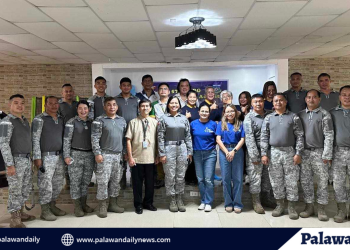The Bureau of Fisheries and Aquatic Resources (BFAR) spearheaded the benchmarking of the Ecosystem Approach for Fisheries Management (EAFM) to all Local Government Units (LGU) within Palawan including Puerto Princesa City on Tuesday, August 17, 2021.
The activity was conducted through online platforms and the breakout session per LGU was conducted afterward.
All 24 LGUs in Palawan participated in the benchmarking including key officials in the local offices of agriculture, environment and natural resources, planning and development, and Bantay Dagat or similar local bodies that led the fishery law enforcement. Each LGUs were provided with EAFM toolkit and Governance Benchmarking Scoresheet which consists of 15 benchmarks.
Core to the activity is the sustainable fisheries planning and management that is linked to catch documentation and traceability and human welfare objectives. The overall goal of the program includes improved fisheries management through sustainable fisheries plans, focusing on the ASEAN and the Coral Triangle Initiative member countries, data-driven fisheries management, support traceability objectives, and are inclusive of human welfare concerns.
Representing Puerto Princesa City was City Agriculturist Melissa Macasaet, Aquaculturist Joven Delgado, Senior Environmental Management Specialist (SEMS) Cardelar Stevie Angel M. Madriñan, chief of the City ENRO’s Enforcement Division and Community Development Assistant I Gerardo C. Reyes Jr.
Palawan archipelago belongs to Fisheries Management Area (FMA) 5, one of the 12 FMAs in the country.
In 2019, the Department of Agriculture -Bureau of Fisheries and Aquatic Resources (DA-BFAR) issued the Fisheries Administrative Order No. 263 (FAO 263) which established the 12 FMAs covering all Philippine waters. It encouraged all coastal LGUs as fisheries managers to take on shared responsibilities for the conservation and sustainable management of fishery resources.
An EAFM is an integrated management approach across coastal and marine areas and their natural resources that promotes conservation and sustainable use of the whole ecosystem. It is one of the programs assisted by the United States Agency for International Development (USAID).
USAID Oceans uses the EAFM, which shifts away from the single-species fisheries management approach towards an approach that seeks to balance ecological and human well-being priorities through effective fisheries governance. It is a practical way to achieve sustainable development while maximizing the ecosystem benefits of a fishery. It also addresses non-target species, endangered species, minimizing waste and pollution, biodiversity, and welfare of the coastal population, including subsistent fisherfolk.




















Discussion about this post